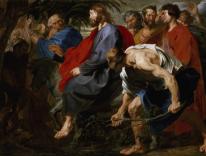When I was young, one of my favorite parts of the Palm Sunday liturgy in El Paso, Texas, was watching people, mostly older women, take the piece of blessed palm they had received and turn it into something completely different. After the initial waving of palms and the opening prayer, we all sat to hear from Isaiah:
4 The Lord God has given me
a trained tongue,[a]
that I may know how to sustain
the weary with a word.
Morning by morning he wakens,
wakens my ear
to listen as those who are taught.
5 The Lord God has opened my ear,
and I was not rebellious;
I did not turn backward.
6 I gave my back to those who struck me
and my cheeks to those who pulled out the beard;
I did not hide my face
from insult and spitting.
7 The Lord God helps me;
therefore I have not been disgraced;
therefore I have set my face like flint,
and I know that I shall not be put to shame (NAB translation)
Some of the people in the pews would look at the palm they had received to imagine their new creation. As the Liturgy of the Word continued, I would watch people take their single piece to multiply it toward a new creation. Sometimes, I would hear quick zipping noises as one side of the palm was torn from the others and then again into multiple small strips. Most people made some form of a cross. Some created more intricate pieces in addition to the cross. Some would weave their additional strips around the cross to create an ojo de Díos (God’s eye) while others would shape and attach a rose.
The readings and homily continued in the background as these people seemed to take the words that were being spoken and interlace them as new expressions from a palm. Sometimes, a piece of palm would cut someone’s hand. They would reach for a piece of cloth or a tissue to apply pressure and stop the bleeding before continuing. Palms can cut. Palms can be used to scourge. As the fingers worked, the forming of the palm could yield a tool or a weapon—or simultaneously both, like the flint in Isaiah’s words.
The first time I saw this practice, I watched in amazement. The following year, I began to shape my own palm. I learned by watching the people around me. I was “traditioned” into this popular devotion without these people even knowing. They were the learned, sustaining life and the weary with their incarnated words and shaping a new creation.
The people who continue to engage in this practice speak with their hands. They create out of simplicity. They convert something from a simple palm to a religious piece that will later hang in someone’s house or car. They will be the marks of blessings of their work. These simple single palms have been multiplied by those who form them. The weavers respond to the vocational call found in Isaiah. Many months from now, when the blessed palms reach their end, they will be burned for use at Ash Wednesday. They will be blessed again and multiplied on the faces of the many gathered.
As we know, “Lent” is a shortened form of “Lente” which means springtime—literally, a time when new life springs. Often, Lenten messaging focuses on individual renewal and purification. This practice of creating something more complex from a simple palm attends to the importance of sustainability, and in its literal interweaving the palm itself can be seen as a symbol of the inseparability of all of life. Those of us who live in the northern hemisphere are privileged to have this liturgical season align with the seasons as understood by the Gregorian Calendar. I am drafting this piece on the spring vernal equinox of March 20, 2023. This past weekend, we planted seeds that will hopefully yield tomatoes through the month August. But we should remember that the southern hemisphere experiences Lent in a season like our autumn.
As Christians, we believe in incarnating words. We follow both Hebrew and Christian Scriptures. While Isaiah 50:4-9 contains its own call-and-response, call-and-response becomes a recurring theme in the gospels. As was celebrated on the fourth Sunday of Advent of this liturgical year, Mary is called by God and is found with child through the Holy Spirit (Matthew 1:18-24). In today’s reading of Matthew 21:1-11, the disciples are called by Jesus to fetch the ass and colt. Like the Word made flesh by Mary and the response of the disciples, God calls us to spread the Good News (evangelize), which is the Word of God. We do that through actual words. Also, as the Marianist virtues teach through the silence of words and the silence of signs, a faithful response to God’s call is to sharpen our faces and our communities like flint—not as weapons, but as tools of creation and sustainability. And we understand that as we and our systems are so deeply embedded within social sin, we will need to do so again the following year, when once more we burn our beautiful palm creations and spread them across our faces.
Please email comments to [email protected] and join the conversation on our Facebook page.
Previous Story
What Do Movies Remember?
Next Story
Hoover’s America


